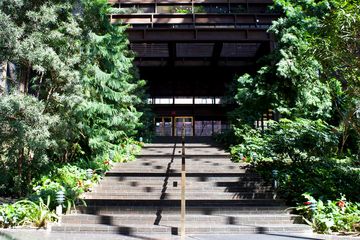What do Miami Beach, a drugs bust, God Bless America and the the People’s Republic of China have in common? They all come together in the dazzling (sometimes checkered) history of the Chinese Consulate on the corner of the West Side Highway and W42nd St.
The oddly shaped building began its life in 1962 as a Sheraton Motor Inn, designed by Morris Lapidus (who also was the lead architect for Miami Beach’s famous hotels, including the neo-Baroque Fontainebleau and Eden Roc). In total, Lapidus designed 1,200 buildings, including 250 hotels worldwide.
During his career, his work was characterized by the American architectural establishment as gaudy kitsch. Ada Louise Huxtable, writing in The New York Times, said of the Americana in Bal Harbor. “The effect on arrival was like being hit by an exploding gilded eggplant.”
Art in America deemed his work “pornography of architecture.”
Lapidus tried to ignore the critical panning, but it had an effect on his career and reputation. He burned 50 years’ worth of his drawings when he retired in 1984 and remained bitter.
New York Magazine always seemed to lead the charge. In 1969, in its first Annual Cityscape Awards, it gave the Sheraton Motor Inn the Miami Beach Laurels for “combining within the volume of a modest hostelry every single design cliche produced by the so-called International Style during the past 50 years.”
In 1971, the same magazine said: “Room service at the Sheraton Motor Inn … wasn’t it conceived as a cheaters’ hideaway? Would any tourist in full possession of their sensitivities really choose to lodge overlooking the drudge of the West Side Highway and the venomous Hudson?”
But Lapidus wasn’t without his supporters. In 1962, the editors of The New Yorker described the new Sheraton Motor Inn as “a startlingly classy pioneer in a somewhat declasse neighborhood.”
Architecture experts today do not consider the Consulate as a pure representation of Lapidus’s work. Kathleen Randall from Docomomo (an organization committed to the conservation and documentation of buildings in the modern movement), speaking in 2005, said: “The Sheraton Motor Inn at 42nd Street and the Westside Highway was completely reclad and reworked three years ago for a consulate building and is no longer recognizable as Lapidus’s work beyond the structure’s massing.”
This story was adapted from the W42ST article, "Chinese Whispers — How Lapidus’s Sheraton Motel Became China’s Consulate."



